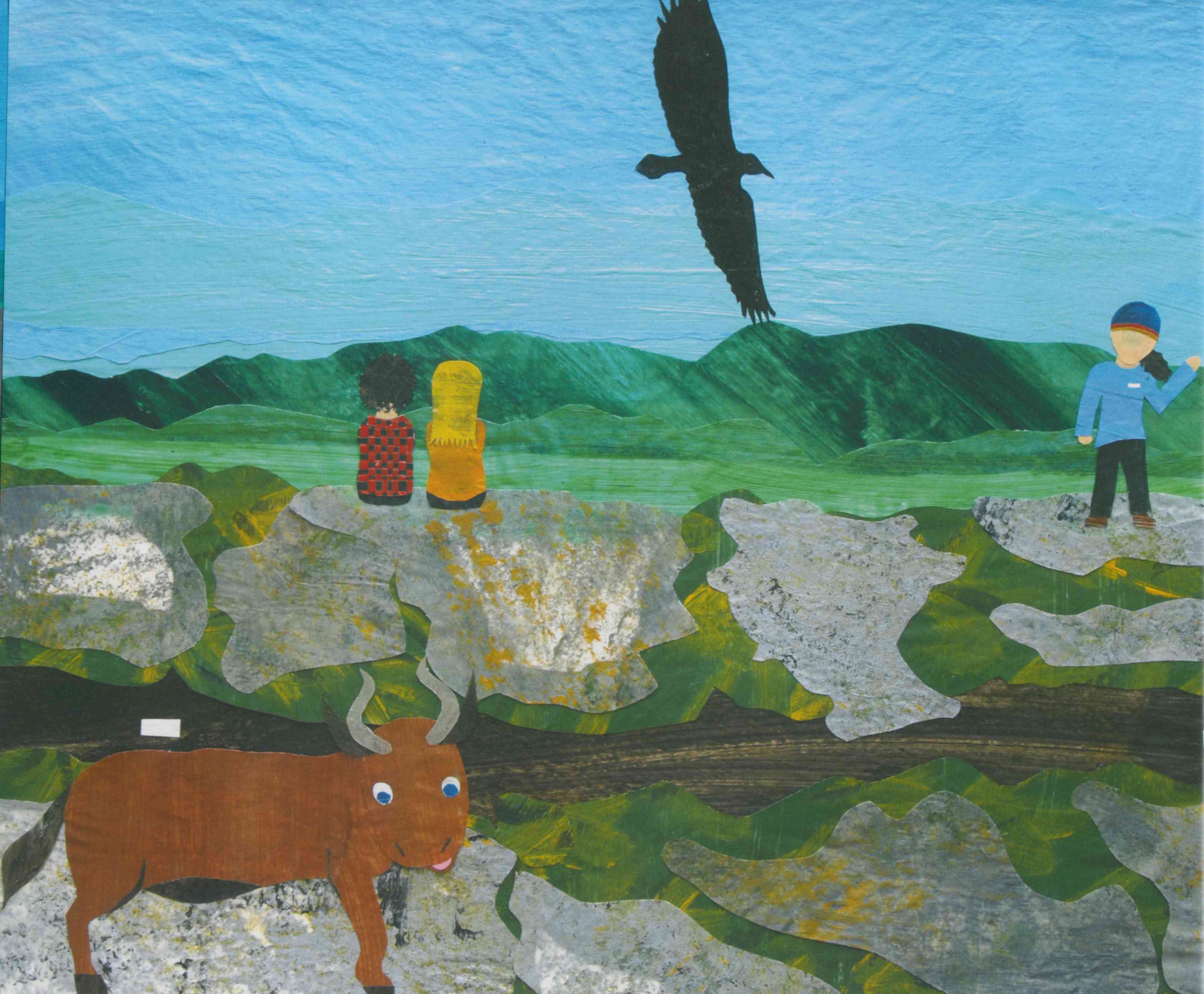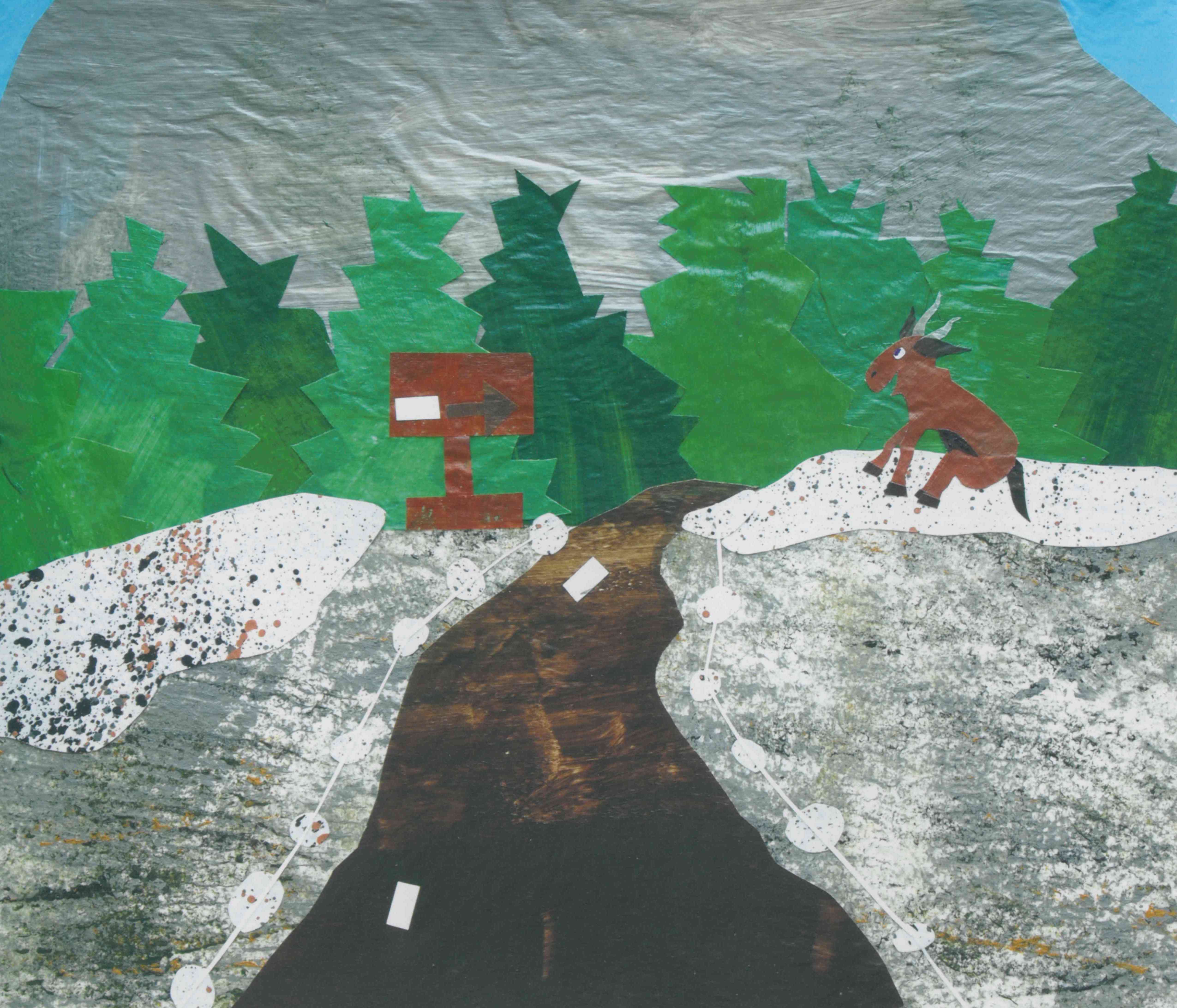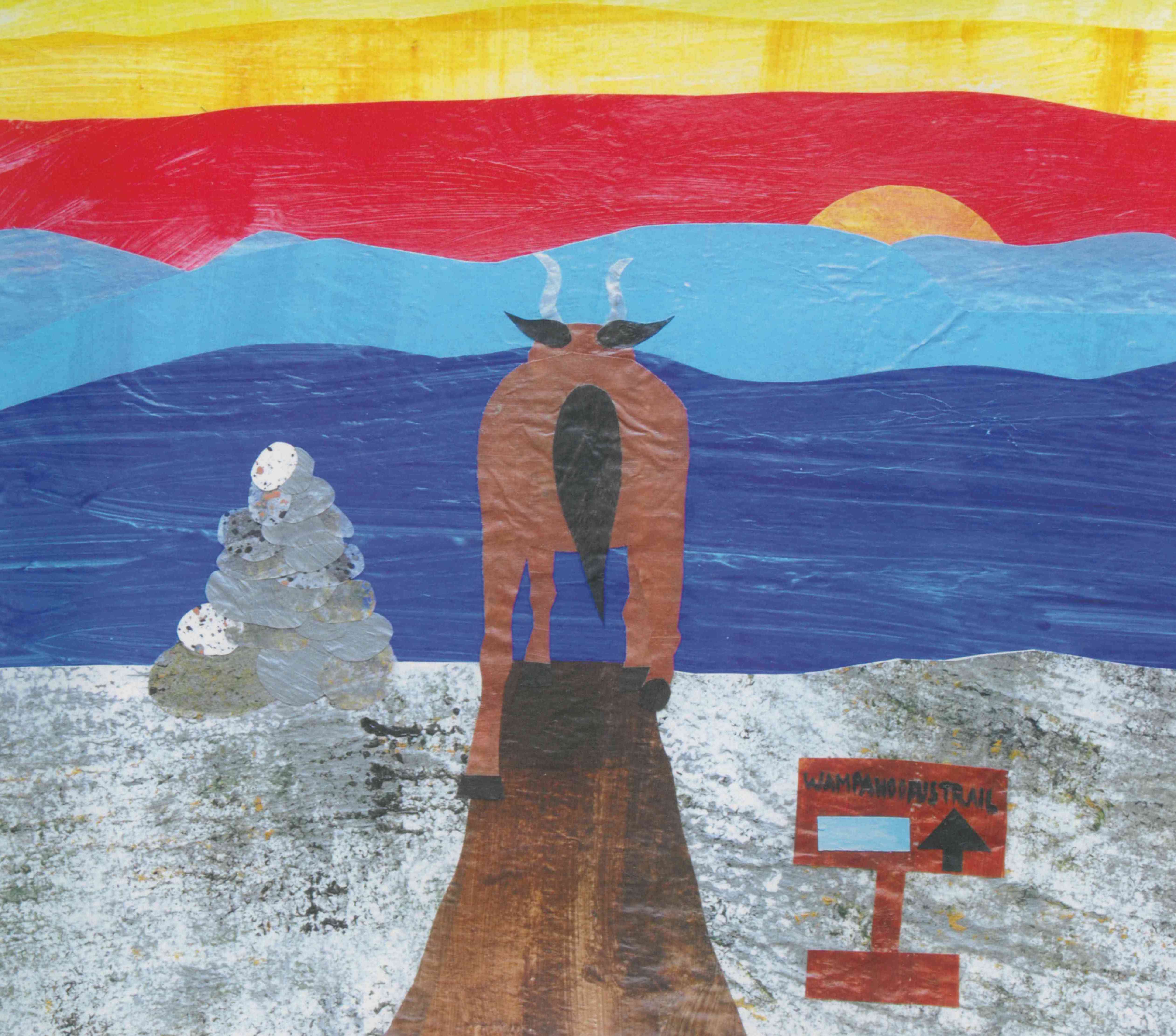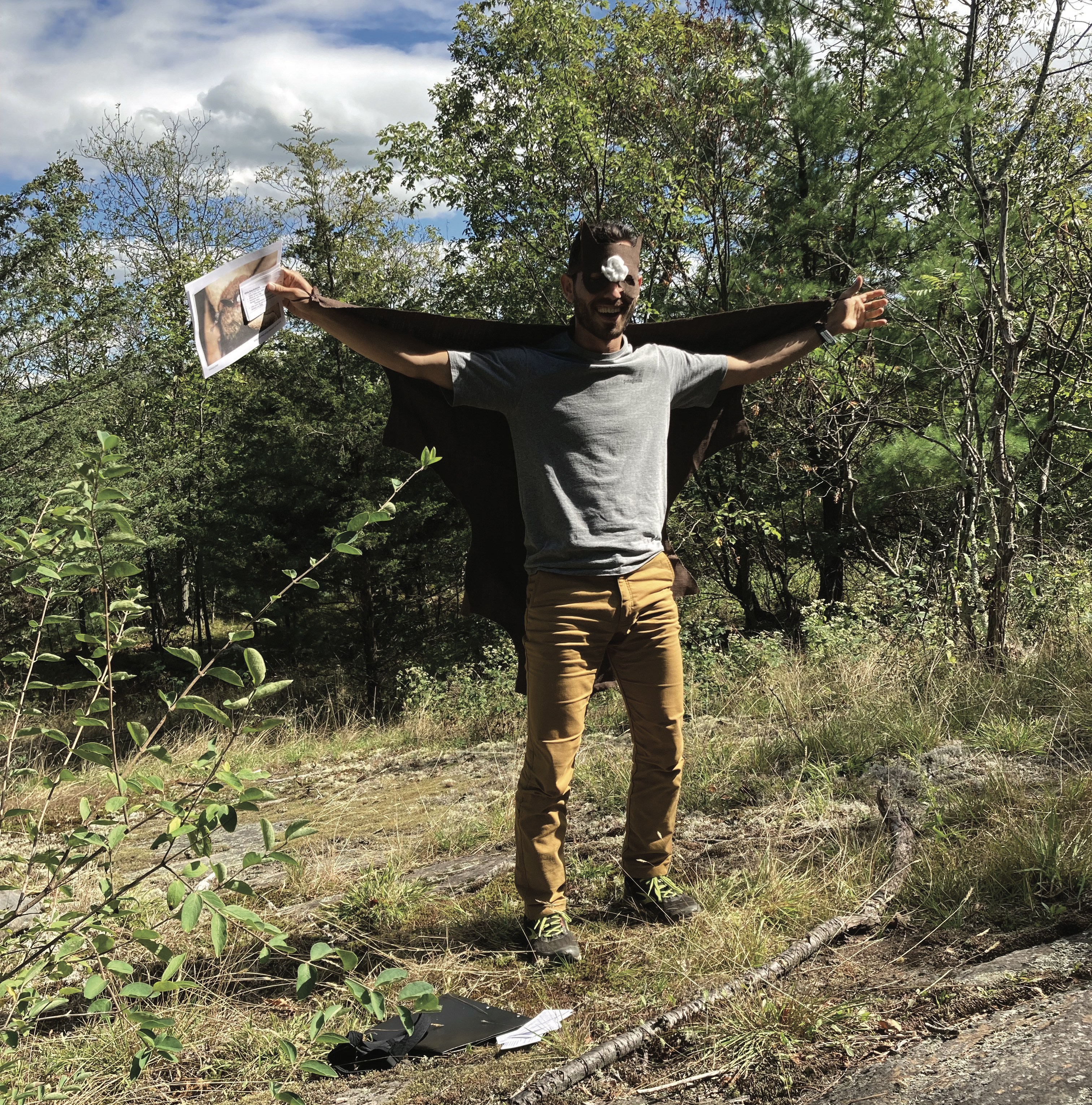On a windy March morning, I left my vehicle at the entrance of Underhill State Park in the foothills of Mt. Mansfield and set out on the hunt for a wampahoofus. What, you ask, is a wampahoofus? A wampahoofus is a kind of sidehill gouger, a fearsome hillside creature with sharp, intimidating horns. Technically, a wampahoofus is a cross between a moose, a bear, a deer, a goat, and a boar—complicated genetics for sure. Other recent studies describe a wampahoofus as a small, docile, herbivorous animal similar to a porcupine, but that’s a dubious claim.
Whatever the taxonomy, the wampahoofus evolved in Vermont and now roams between 2,600 and 3,200 feet in elevation around Mt. Mansfield. It has legs that are shorter on one side than the other, an asymmetrical adaptation unique to the natural terrain of a steep mountain. A wampahoofus can only move in one direction—turning around would cause it to fall over and tumble down the mountain to its death. Males and females have opposing shorter sides, right for males and left for females. That means males move clockwise around the mountain while females move counterclockwise, meeting at opportune moments to mate.
I looked but did not cross paths with a wampahoofus. There was no sign after hiking along the mountainside—no diagnostic hoof-like footprint. I found only tracks of snowshoe hare beneath red spruce and balsam fir. Some claim that the wampahoofus has gone extinct due to breeding difficulties. However, a rock outcropping on Mt. Mansfield that looks like a wampahoofus reminds hikers of the beast. And the loud noises echoing from the Ethan Allen Firing Range sound like its deafening call, so it’s hard to be sure.

After failing to find a wampahoofus, I decided to chase down Champ, the famed lake monster swimming in the depths of Lake Champlain. There is a delight to the mysterious, and there may be something out there to find. Still optimistic, despite not seeing anything on the hillside of Mansfield, I decided to call in an expert on my quest.
Dr. Ellen Marsden, a fisheries ecologist and professor at the University of Vermont, is no stranger to Lake Champlain and Champ. She’s been studying the waters off the shores of Burlington for more than 20 years. Admittedly, Dr. Marsden is tired of people asking her questions about Champ since she first reported on it in the early 2000s for ECHO, a science and nature museum on the Burlington waterfront. After all, easier-to-find monsters need our attention, like the lake sturgeon, which many states list as endangered, Vermont included.
Champ is said to look like Nessi in Loch Ness: a plesiosaur with a long neck, a humped serpent-like body, and large fins. In a recent article, Dr. Marsden addressed these physical characteristics and showed how the typical lake monster fails to hold up to science. But the biggest problem is that people identify only one individual in reports and sightings—this lake monster must be ancient if there is only one of its kind.

Conservation genetics research shows there should be more than 5,000 Champs to sustain populations over generations and avoid inbreeding (also problematic among wampahoofi). Thoroughly studied food-web models would not balance if a large population of unknown organisms was present. Dr. Marsden also noted that long necks characterize these monsters as air-breathers required to lift their heads above the water. If 5,000 Champs must surface to breathe at least 12 times a day (based on the absolute minimum of a whale), then the population would have been seen by now. Did you say, “Test for environmental DNA”? Interesting idea. With that evidence, there is even less of a chance of proving Champ exists.
So, if the probability of a population of monsters living in Lake Champlain is essentially zero, why do sightings of Champ keep happening? Stories of a monster in Lake Champlain began long ago, with Abenaki legends about a giant creature inhabiting the waters, believed to be a horned serpent. The Abenaki term for the monster is “Gitaskog,” and the Abenaki warned colonizers not to disturb it. Early reports often credit Samuel de Champlain, the lake’s namesake, as the first European to spot Champ, but his ac- counts show that he saw something near the St. Lawrence River. Other sightings appear throughout history, most notably in the 1800s when a boat captain claimed to see a monster in Bulwagga Bay.
With no actual method or plan, I picked a warm, sunny winter day and sat on the rocks at Oakledge Park in Burlington for hours, trying to scour every meter of the lake in my view. Some common mergansers dove underwater, but that was the only excitement on the lake. With the sun shining, I thought I might get lucky and see one sign of Champ. But I did not have high-tech underwater cameras, hydrophones, or a boat to scan the lake bottom with sonar. I did not see a lake monster or find any evidence. Otherwise, you likely would have seen it in the New York Times. As it turns out, Dr. Marsden said that all “sightings” occur in poor light conditions or fog.

There are countless dramatized videos across the internet of cryptozoologists and investigators documenting the “movements” of Champ in the lake. Dr. Marsden believes that “with one bit of mass hysteria, there is often buy-in,” and people will believe something is out there. Humans are amazingly complicated. “To disprove something, we have to explain every meter of the lake,” she said. But Dr. Marsden is convinced most rational people know legends are not real.
I did not expect to find a wampahoofus or Champ. And I didn’t. Despite the resounding evidence against the existence of these creatures, Dr. Marsden gave a glimpse of hope—she reminded me there is no harm in educating kids about the Lake Champlain monster or other fabled creatures. If searching and learning about these legendary beasts excites people to go for long walks in the woods, “they will see everything else out there. It’s all good. It [encourages] children to question what could or could not be.”
I used to walk through make-believe doors as a child. Portals transported me to fantastical worlds with fantastical creatures, making the ordinary world seem magical too. I no longer see them as an adult. But growing up doesn’t mean I have to lose my sense of wonder. My backyard has an endless cabinet of curiosities to explore, where mysterious beasts lurk in the dark forests and deep lakes of the Green Mountain State. There are cryptids, creatures whose existence is scientifically unproven, that live beyond stories. These legends should encourage adults to wonder about the natural world the same as children.

Zoe Linton, a former graduate student at the University of Vermont, wrote a children’s book about the wampahoofus for her master’s project. Drawing inspiration from her time as a summit caretaker on Mt. Mansfield, Zoe used the wampahoofus as the main character to make alpine plants and animals more fun. She loves the name of the Wampahoofus Trail: “It provides an angle of mystery for other hikers, and they believed [they heard] the call of a wampahoofus. It adds to the experience of hiking Mansfield.”
Zoe grew up in Vermont, connected to the local culture and close to the land. She’s interested in cryptids, “the weirdest supernatural subjects,” and has a similar sentiment to Dr. Marsden regarding legends. “I’m hopeful that Vermont will keep these legends alive.” The wampahoofus “enhances the curiosity of the mountain. Any baseline understanding expands curiosity, and curiosity breeds discovery [of] the responsibility to care for and conserve natural spaces.”
In Iceland, it’s relatively common for adults to at least entertain the possibility of the existence of elves. A recent book, Looking for the Hidden Folk by Vermont author Nancy Marie Brown, explores how Icelanders use stories of elves to express their concern for their environment. Elves represent a special connection with the natural landscape that can be difficult to explain, altering our perceptions of the environment. The mountains and rivers hold significance as elven homes, and believing in these beings is an at- tempt to protect something worth keeping. Suppose there were a place in the United States with a similar connection to legendary beings to that in Iceland. In that case, Zoe says, “Vermont has a good shot [at] using the supernatural for environmentalism.”

If we found a lake monster skeleton or wampahoofi scat, they surely would make excellent company for the Charlotte whale— rewriting the history of evolution around here. I want to believe in wampahoofi. I want to believe in Champ. I want to believe in every cryptid that lives in beautiful lakes and forests across the planet.
There is humility in the struggle to know. Dr. Marsden believes, “It’s nice to know everything, but we just don’t. We haven’t even begun to discover everything out there. Legends add a little mystery and a little humility to the adventure.” Science does not support the existence of Champ or the wampahoofus. And that’s okay. But disbelief should not be the default.
The more knowledge I gain about the natural world, the more amazed I am at how much greater mysteries become. I will not al- low others to deride my sense of wonder or disenchant my world. Chasing after the wampahoofus or Champ reminds me of the spiritual richness that nature provides. Legends can integrate the human world with the not-so-human. Just as I did as a child, I need the magical atmosphere these stories create.



